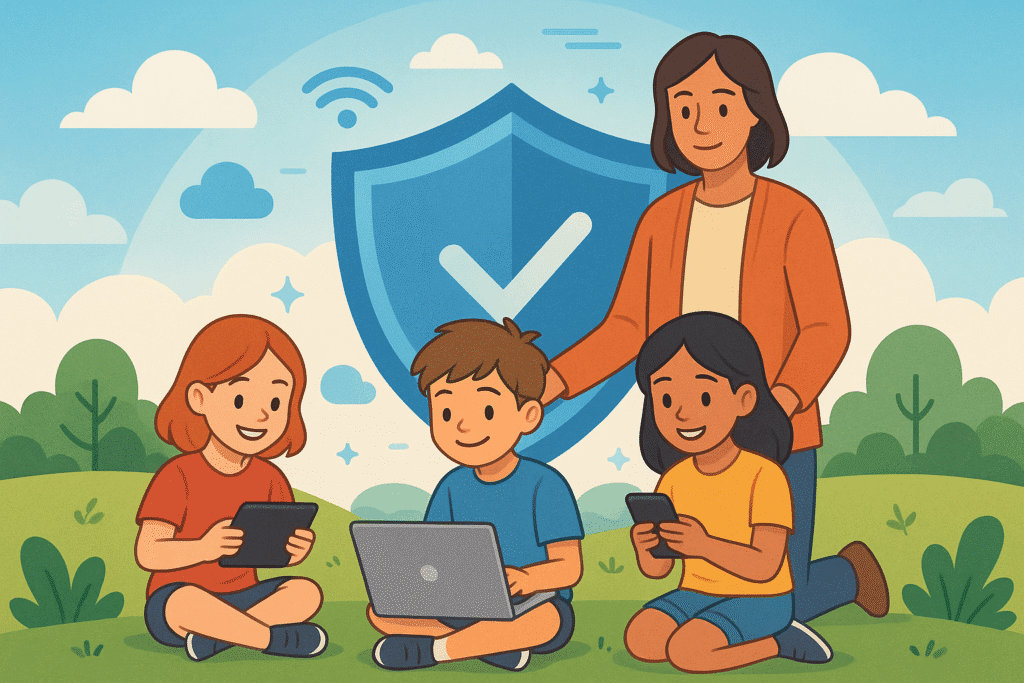Nowadays, an increasing number of digital internationals protect children online, which has by no means been more vital. With smartphones, pills, and laptops turning into everyday necessities for kids, the risks associated with internet use are rising sharply. The Online Safety Act emerges as a pivotal framework aimed at creating a more secure online environment. In this text, we’ll dive deep into what the Online Safety Act includes, why it matters, and sensible steps parents and guardians can take to shield children online.
What Is the Online Safety Act?
The Online Safety Act is landmark regulation brought to modify online structures and put in force stricter responsibility for harmful content material. The number one goal of the act is to make the net a safer location, particularly for children and prone customers. It mandates social media businesses, messaging offerings, and other digital platforms to actively save you from publicity to dangerous content, which includes cyberbullying, baby sexual exploitation, and violent content material.
The act empowers regulatory bodies, inclusive of the Office of Communications (Ofcom) within the UK, to best corporations that fail to comply with protection standards, put into effect content takedowns, or even block admission to non-compliant systems.
Key Features of the Online Safety Act
Duty of Care: Online systems have to take affordable steps to shield customers, especially youngsters, from unlawful and harmful content material.
Transparency Reporting: Companies are required to publish normal reports on their content material moderation efforts.
Risk Assessment: Platforms ought to assess the dangers related to their services and put in force protection measures hence.
User Reporting Tools: Easy-to-use systems for customers to record dangerous content material.
Enforcement Powers: Regulatory bodies have the authority to impose heavy fines and, in intense instances, restrict entry to offerings.
Why Is the Online Safety Act Important?
Children nowadays spend an extensive quantity of time online for education, socialization, and leisure. While the internet offers valuable resources, it also exposes them to risks like
- Cyberbullying
- Exposure to irrelevant content material
- Online predators and grooming
- Privacy breaches
- Mental fitness issues due to social media stress
Before the Online Safety Act, responsibility for online harm became loosely dispensed and often useless. Now, the act places clear legal duties on corporations to lay out safer platforms proactively instead of reactively.
How the Online Safety Act Helps Protect Children
Safer Content Moderation
The act calls for online platforms to install extra effective content material moderation strategies. This includes the usage of AI-driven moderation tools and human review groups to stumble on and get rid of harmful content material unexpectedly.
Child-Friendly Platform Design
Tech businesses are advocated (and in some instances, mandated) to construct services with protection by using layout. Features like default privacy settings, limited direct messaging, and automatic content material filtering are getting preferred.
Greater Accountability
Fines and penalties for non-compliance make sure that businesses take consumer safety critically. Knowing that failure to guard children may result in sizeable monetary and reputational harm is a sturdy motivator for businesses to behave responsibly.
Empowering Parents and Educators
The Online Safety Act promotes the development of educational resources for dads and moms, guardians, and educators. This guarantees adults are better prepared to recognize online risks and manage children appropriately.
Practical Steps to Protect Children Online
While legislation just like the Online Safety Act offers a regulatory backbone, dads, moms, and guardians should additionally take proactive steps. Here are some effective techniques:
1. Open Communication

Encourage open discussions about online sports. Make certain youngsters experience feeling comfortable reporting something that makes them uncomfortable or scared.
Tip: Regularly ask questions like, “What’s your favorite internet site or app?” or “Has anyone online ever made you feel uncomfortable?”
2. Use Parental Controls
Take advantage of parental manipulation equipment supplied by using gadgets, apps, and internet carriers. This gear can block inappropriate content material, set display screen cut-off dates, and screen hobbies.
Popular Tools:
- Apple Screen Time
- Google Family Link
- Qustodio
- Norton Family
3. Educate About Online Privacy
Teach kids the importance of safeguarding private data. Explain why they should by no means share their complete name, address, faculty call, or other sensitive facts online.
Key Concepts to Teach:
- Strong passwords
- Two-factor authentication
- Avoiding public Wi-Fi without a VPN
4. Monitor Online Activity
Keep a watch on the apps and video games your toddler uses. Familiarize yourself with the social platforms they’re energetic on and set age-suitable obstacles.
Tip: Co-use gadgets with more youthful youngsters. For teens, have ordinary check-ins without being overly invasive to preserve consideration.
5. Foster Digital Literacy
Help children expand crucial thinking abilities. Teach them to question the authenticity of online chatbots and recognize purple flags consisting of phishing attempts or fake information.
Challenges and Criticisms of the Online Safety Act
Despite its robust protective intentions, the Online Safety Act has confronted a few complaints:
Freedom of Expression Concerns: Critics argue that overly aggressive content material moderation could stifle unfettered speech.
Implementation Complexity: Smaller businesses might also conflict with the financial and technical burden of compliance.
Scope Limitations: Some argue that positive, swiftly evolving online spaces, consisting of decentralized platforms or emerging AI technologies, may not be competently included.
It’s essential for the rules to strike a balance among protection, innovation, and freedom.
The Future of Online Child Safety
The Online Safety Act represents an extensive step forward, but online safety is an evolving panorama. Emerging technologies like augmented reality (AR), digital fact (VR), and AI-driven content introduction present new challenges.
Continuous updates to rules, ongoing technological innovation, and sturdy collaboration among governments, tech agencies, educators, and mothers and fathers are critical to future-proofing children’s online safety.
Conclusion
The Online Safety Act is a groundbreaking move closer to a more secure internet, particularly for youngsters. By protecting responsible tech companies and empowering Dad and Mom and educators, it addresses some of the dangers lurking online today.
However, legislation on my own isn’t always sufficient. Active parenting, open conversation, virtual literacy education, and responsible era use are equally important in growing a secure and effective online realm for kids.
In the quest to protect children online, it is a shared responsibility — and it starts with awareness, training, and action.



